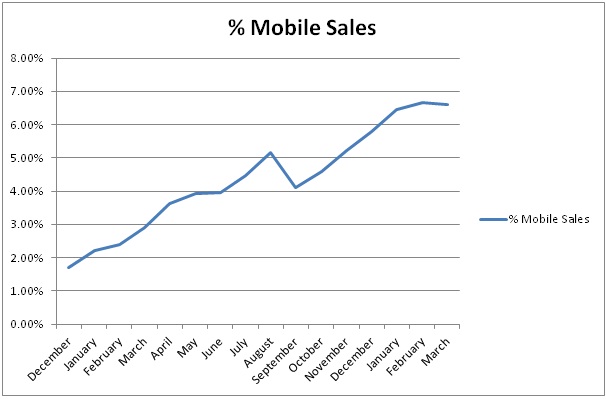 With consumer behaviour and shopping habits continually evolving, coupled with the increase in smartphone penetration, more and more consumers are accessing the internet through mobile devices.
With consumer behaviour and shopping habits continually evolving, coupled with the increase in smartphone penetration, more and more consumers are accessing the internet through mobile devices.
This is something that we have been monitoring closely at Affiliate Window for the past 18 months. Back in December 2010 we saw traffic through mobile devices account for 2.4% of all network traffic and 1.7% of all sales.
Fast forward to March 2012 and these figures have grown considerably with 10% of traffic and 6.6% of sales coming through mobile devices.

In addition to this, taking into account growth rates we experienced throughout 2011, we forecast that by the end of the year approximately 14.5% of all transactions will have taken place through mobile devices.
The importance of optimising for mobile
With the volume of clicks that are now driven by this channel, it is important that advertisers are in a position to be able to convert this traffic.
There is still an alarming number of retailers that do not have mobile optimised versions of their site. This makes the process of viewing products, adding them to a basket and ultimately converting a fiddly process.
This has led to conversion rates through mobile handsets dropping as the amount of traffic through the devices has increased. While mobile is increasingly used in the research phase of a customer journey, visitors are not being converted due to a poor user experience.
Where we have advertisers that have launched a mobile optimised version of their site, complete with affiliate tracking, figures have been impressive.
For one advertiser we have seen sales through mobile devices increase from around 2% to 16% of all transactions through the affiliate channel.
Mobile and average order values
It is not just about seeing a greater volume of sales coming through mobile devices, we are also seeing an impact on the average basket values.
We have been able to monitor the average order values of customers that have bought through a mobile device and compare these when visiting the e-commerce version of the site vs. the fully optimised m-commerce site.
Through Android devices, average order values were found to be 40% higher through the mobile optimised version of the site and above that of desktop. Similarly, basket values through the iPhone saw a 25% increase when coming through the mobile optimised site rather than the full e-commerce site.
Affiliate tracking
As well as a poor user journey being partly to blame for the drop in conversion rates, this can also be attributed to advertisers not including affiliate tracking within their mobile sites – meaning that not all sales through the affiliate channel are tracked.
Despite there being a significant rise in mobile usage, there is a fundamental disconnect between what some of the largest brands in the country are doing in the running of their affiliate campaign and the preparedness for the implications of m-commerce on affiliates.
When accessing an advertiser's site through a mobile device, by default the m-commerce version of a site (if available) will load. This highlights how problematic it is when affiliate tracking is not in place.
Advertisers who have embraced mobile and have developed mobile optimised sites may miss out on a significant number of opportunities that present themselves through the affiliate channel if they neglect the importance of adding affiliate tracking.
Mobile traffic has been increasing month on month and our stats indicate that this growth will not be slowing any time soon.
Developing mobile optimised sites will definitely help improve user journeys and place advertisers in a better position to convert the increasing number of visitors through mobile devices.
However, to really take advantage of the mobile opportunities presenting themselves through the affiliate channel, it is imperative that affiliate tracking is put in place.
Matt Swan is Client Strategist at Affiliate Window and a guest blogger on Econsultancy.
No hay comentarios:
Publicar un comentario